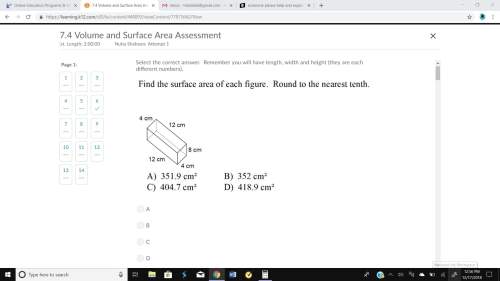
Mathematics, 24.04.2022 20:20, theannakittler7327
The double number lines show the ratio of feet to miles.
A double number line with 4 equally spaced tick marks. The line labeled Feet, reads from left to right: 0, an unlabeled tick mark, 10,560, an unlabeled tick mark. The line labeled Miles, reads from left to right: 0, an unlabeled tick mark, 2, an unlabeled tick mark.
A double number line with 4 equally spaced tick marks. The line labeled Feet, reads from left to right: 0, an unlabeled tick mark, 10,560, an unlabeled tick mark. The line labeled Miles, reads from left to right: 0, an unlabeled tick mark, 2, an unlabeled tick mark.
How many feet are in 333 miles?

Answers: 3
Other questions on the subject: Mathematics

Mathematics, 21.06.2019 14:40, hannamcbrayer1
Which statement most accurately describe why the division property of exponents does not apply to the expression (-8)^2/(-3)^4
Answers: 2

Mathematics, 21.06.2019 20:00, tansebas1107
Can you me find the missing length. i attached an image.
Answers: 1

Mathematics, 21.06.2019 20:30, kaliyaht01
The frequency table shows the results of a survey comparing the number of beach towels sold for full price and at a discount during each of the three summer months. the store owner converts the frequency table to a conditional relative frequency table by row. which value should he use for x? round to the nearest hundredth. 0.89 0.90 0.92 0.96
Answers: 2

Mathematics, 21.06.2019 21:30, gonzalezashley152
In a test for esp (extrasensory perception), the experimenter looks at cards that are hidden from the subject. each card contains either a star, a circle, a wave, a cross or a square.(five shapes) as the experimenter looks at each of 20 cards in turn, the subject names the shape on the card. when the esp study described above discovers a subject whose performance appears to be better than guessing, the study continues at greater length. the experimenter looks at many cards bearing one of five shapes (star, square, circle, wave, and cross) in an order determined by random numbers. the subject cannot see the experimenter as he looks at each card in turn, in order to avoid any possible nonverbal clues. the answers of a subject who does not have esp should be independent observations, each with probability 1/5 of success. we record 1000 attempts. which of the following assumptions must be met in order to solve this problem? it's reasonable to assume normality 0.8(1000), 0.2(1000)%30 approximately normal 0.8(1000), 0.2(1000)% 10 approximately normal srs it is reasonable to assume the total number of cards is over 10,000 it is reasonable to assume the total number of cards is over 1000
Answers: 1
Do you know the correct answer?
The double number lines show the ratio of feet to miles.
A double number line with 4 equally space...
Questions in other subjects:




Mathematics, 27.02.2020 21:18












